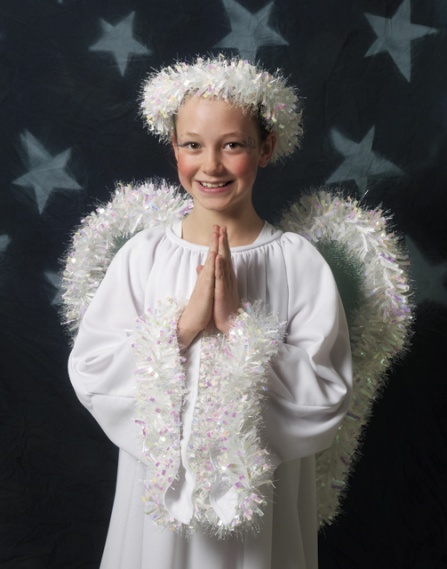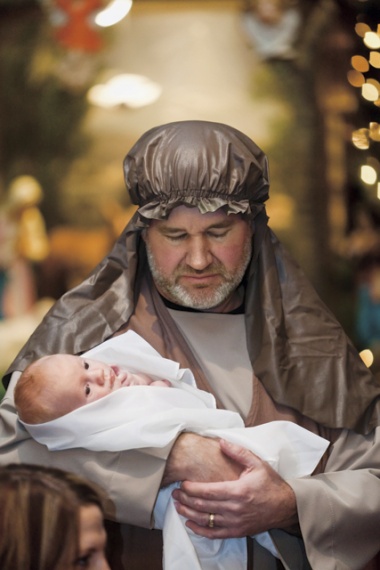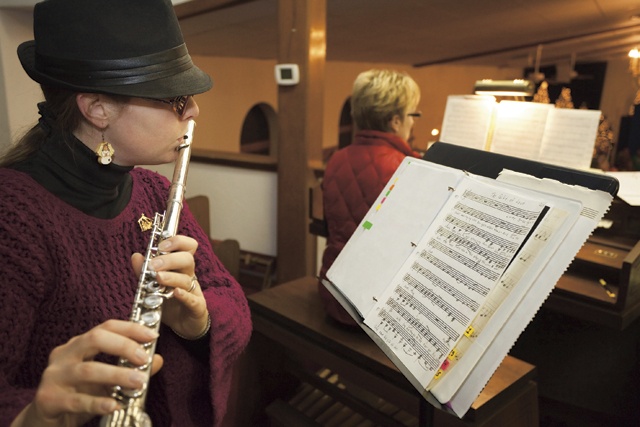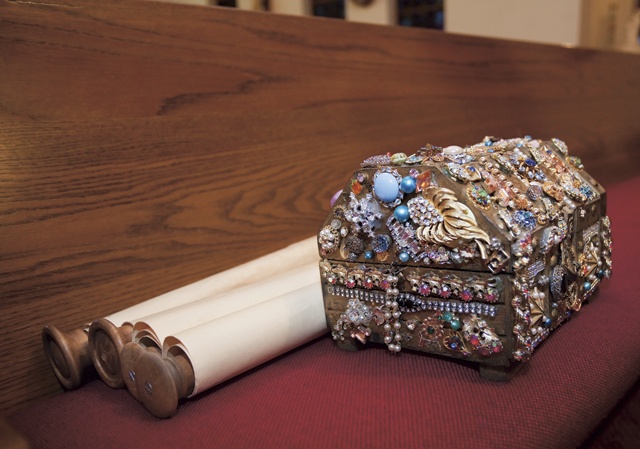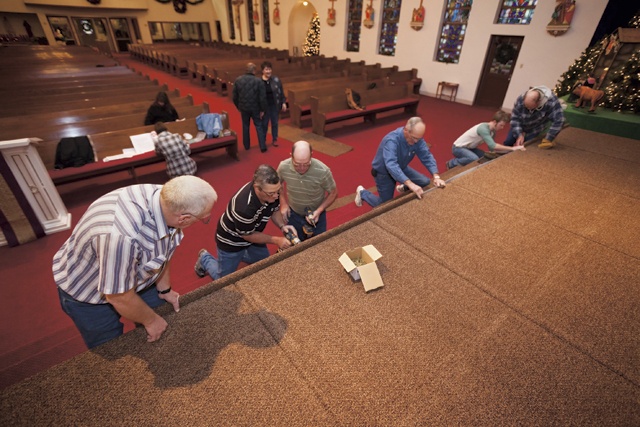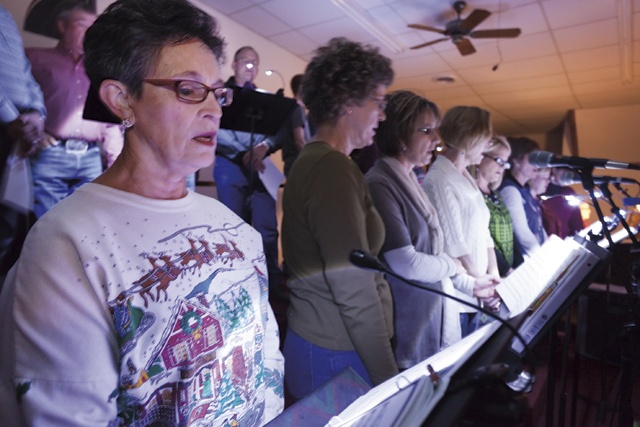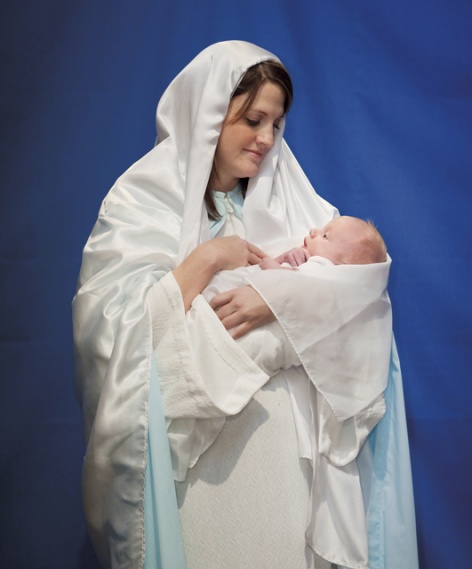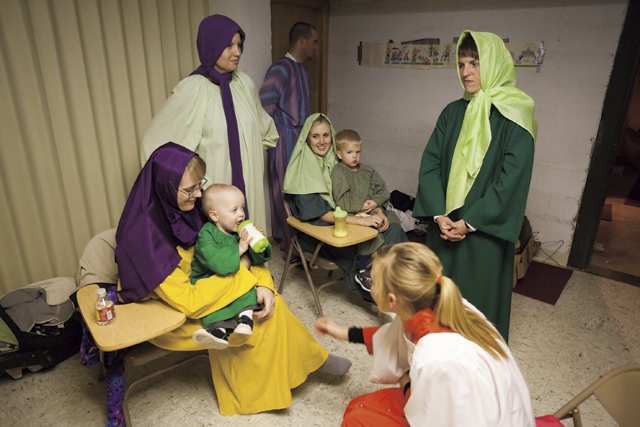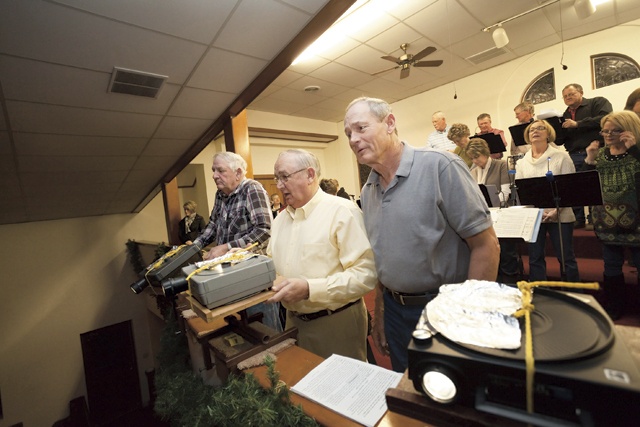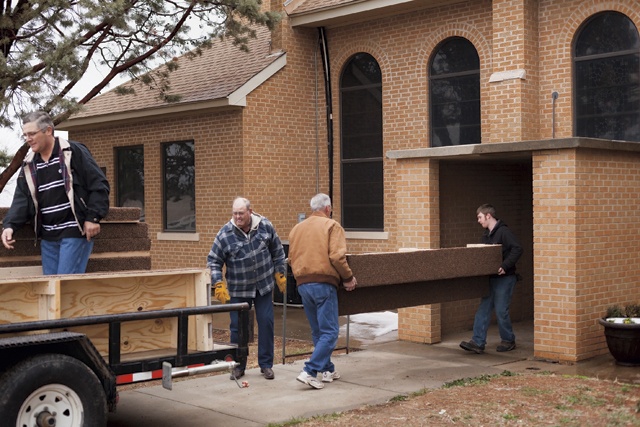The basement of Nazareth’s Holy Family Church buzzed. Cast and crew of the community’s cherished Christmas Pageant bustled in 30-minutes-to-showtime preparation. Villagers from ages infant to 80 had roles in this December 23, 2011, performance, closing the 18th season of a holiday heirloom.
No reason to be nervous, but I was, strolling among performers, camera ready, having already done my publicist job. Lurking behind the scenes fit better than a pew upstairs.
Eyeing a shepherd on a step, I photographed him—texting—thumbing technology I hoped he’d silence lest it chirp while tending flocks by night.
Young angels clad in snowy white perched ’round a table, glittered faces sparkling. Tinseled wings flexing, they fixed rapt attention on Nicole Schulte. The co-director was altering a scene. Tall, trim, intense, Nicole paced, humming, seeking a cue for angelic arrival.
Close by, Harvey Milton, robed as Zacharia, fretted. Once he fell to his creaky knees in fear of Angel Gabriel, he might not be able to get up.
“Spray your knees with WD-40,” I advised.
“Nah. I already told Angel Gabriel he may have to work a miracle,” mustachioed Harvey countered.
Joe Hochstein, towering, luminous Angel Gabriel, had his own issues. Head costumer Cince Hoelting Schulte noticed a wing askew, nabbed him by the arm, hauled him next to a staircase and—with safety pins clamped in her lips, eyes squinted—mumbled, “Be still, be still.” Cince, on tiptoe atop the third step, fixed Joe’s flight gear.
Wise men Matt Olvera, Derrick Schacher and Mark Kleman mashed crowns atop their heads, fiddled with sashes and floor-length robes, practiced majestic bearing.
In a corner, farm boys and bankers shucked boots and jeans for the bare-limbed look of short pants, gold lamé cloth armor, imitation leather skirting, sandals. Norman Gerber, Troy Ramaekers, Marcus Brockman and Curtis Durbin wrapped lengths of leather-looking cloth around their calves—legionnaire leggings. Mercifully, long scarlet capes would block backside drafts.
Surrogate soldiers gamely slumped into school desks and endured daubing with makeup and lipstick.
Baby Cash Hochstein, infant Jesus this year, was passed among an adoring entourage. If they kept him awake just a little longer, he might lie quietly in his mother Meredith’s arms, gazed upon by his dad, Mickey, during Nativity scenes.
After a pre-performance group prayer, I sprinted around the building and slinked through the main church doors into the dark sanctuary. A restless crowd waited. I took a right turn and headed up stairs to the softly lit choir loft for more pictures.
Friends from growing-up days—Darlene Birkenfeld Schulte, her brothers Bob and Alan, Glenn Ramaekers, Kathy Acker Birkenfeld—on the choir riser flashed smiles. Bean counter Henry Ramaekers and farming brothers Rex and Brian Ramaekers waved from behind narration microphones. Farm neighbor Jim Hoelting and Nazareth Mayor Ralph Brockman hunkered beside slide projector spotlights. Mary Lynn Wilhelm Olvera, playing behind a screen, still never having seen an official performance in all her years of playing, fingered the first organ chords. Warmth welled with the singing: “Welcome, welcome, child of Bethlehem, welcome newly born king.”
This Christmas story, told through a village’s commitment, unity and pride, was almost lost.
Nazareth’s first Christmas Pageant in 1972 culminated a dream of the late Father Stanley Crocchiola, former pastor of Holy Family Church. Artist, author, pageant adviser, cast and crew encourager during the early years, Father Stanley was delighted that Nazareth, named for Jesus Christ’s childhood hometown, shared a Christmas pageant with the Panhandle. He worked with the late Donna Benke Birkenfeld, gifted homegrown writer and musician, who originated and directed the first pageants, writing the script, selecting and arranging music, composing the haunting “Soldier Search” and “Magnificat” music.
Noreen Kleman Carson, sister of current-day director Nicole Schulte, later directed the fifth through eighth pageants and wrote the music “Chosen by God.”
Father Stanley’s art students painted stage backdrops—brushstroke Bethlehem. Timeless stitchers Rosemary Wilhelm, Lucille Drerup, Ann Heck, Ann Schulte—all passed on now—as well as Judy Lange and Norita Hoelting made costumes. Crowns for wise men were crafted from plastic bleach jugs, their robes from priest vestments and communion rail cloth. Fire helmets became soldier headgear. Garbage can lids were shields; canning jars and funnels formed lanterns.
Many generations of parish families became choir and musicians, set and lighting crew, carpenters, welders, electricians, actors, and narrators depicting Christ’s life from the Annunciation in the Galilean village of Nazareth, through his birth in Bethlehem, and the Holy Family’s flight to Egypt and return to Nazareth. Fourteen scenes, 14 songs, faithfully rendered.
Staged annually from 1972 to 1982, and intermittently from 1984 to 1994—the pageant’s initial run was 16 years. The effort was exhausting, even for this close-knit congregation. A year off turned into two, five, a decade, 15 years.
Word of revival came at a German festival in July 2009. I was leaving Nazareth’s Community Hall when Lisa Lacy Schulte, who grew up just down the road from our family farm between Hart and Nazareth, motioned me over.
“Did you know we’re talking about bringing back the Christmas Pageant? We’ll meet about it next week and decide,” she said excitedly.
Lisa and Nicole Kleman Schulte had talked at a family reunion about resuming it.
“Watching as a child left memories of the sweetness of the story, songs that fit scenes perfectly, sense of tradition. I wanted to see the pageant revived so my children and other children could know the true story of Christmas,” Nicole explained.
“A generation of our youngsters had never experienced the Christmas Pageant. Realizing that was all it took to get rolling,” Lisa said.
Parish priest Father Ken Keller urged his flock to take up the project only if they were committed.
“So many people called, took over a committee, jumped in with both feet. They wanted their kids and grandkids to see and one day remember the pageant,” Lisa recalled.
Veterans of pageants past and eager new volunteers pitched in. Jim Hoelting, a director at Deaf Smith Electric Cooperative, has worked in every pageant. Though willing to shinny up streetlight poles as in days past to disconnect lights that might ruin the pageant’s indoor aura, this time he borrowed a bucket truck. Jim and fellow technical crew veteran Ralph Brockman found the original slides—made of duct tape, aluminum foil and washers—that made carousel projectors into affordable spotlights. “Big washer hole, large beam; small washer hole, small beam, way simpler and less costly than high-dollar lights,” Jim told me during a rehearsal.
“This is a fantastic homespun show that everybody missed, a hometown production worth doing. People have to want to do it,” Jim mused.
Norita Hoelting, enduring pageant seamstress, stitched new costumes and repaired and altered old ones. Ilona Schilderink upgraded angel wings with new tulle over wire frames and added garland etching.
The first performance night in 15 years was December 20, 2009, at 7:30. I arrived at 6 to an already half-full sanctuary. By 7, a relay was passing folding chairs for overflow seating.
Alan Birkenfeld leaned close as we hauled chairs, smirking. “You think we had too much publicity?”
A sanctuary that seats just over 700 was cram-jammed—with people from Amarillo, Tulia, Dimmitt, Hart, Hereford, Friona, Plainview, Olton, even Lubbock. The dear old pageant shone anew.
In a follow-up meeting, volunteers agreed to alternate years of staging the pageant. The next performance is in 2013, tentatively scheduled for December 22 and 23.
Memories of pageants past flowed with the music during the final 2011 performance. As the choir voiced “Cherry Tree Carol” in the last scene before the closing acolyte processional, the church was dark. “On a bright Christmas morning,” they sang. Decorated trees and the crèche beside the stage instantaneously twinkled to life. Silent night … love’s pure light.
From the choir loft, the manger and its renewed story of hope are not so far away.
——————–
Jim Steiert is a Hereford writer.
The German and Irish Catholic community of Nazareth’s history as a rural colony in Texas dates to 1902. Nazareth, 76 miles southwest of Amarillo, and Holy Family Church are served by Deaf Smith Electric Cooperative.

